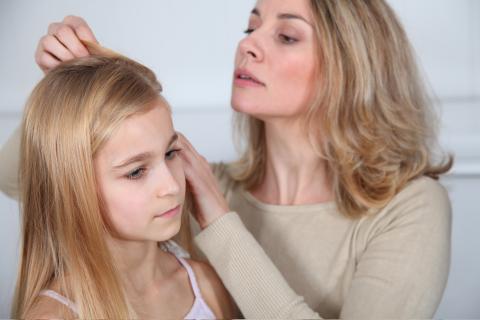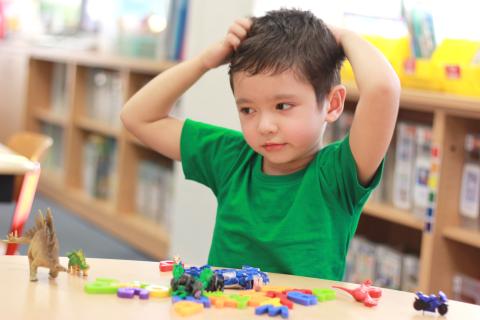Head Lice
Head lice are parasitic insects that infest the head and neck of their host and attach their eggs (nits) to the base of the hair shaft. They can be found on the head, eyebrows, and eyelashes of people. Lice feed on human blood several times a day, which can cause severe itching, but they are not known to spread disease.
Head lice move by crawling and cannot hop or fly. For this reason, head lice infestations are spread by close person-to-person contact. They are most common among young schoolchildren and the household members of infested children.
Anyone can become infested with head lice, but infestations are most commonly found in schools and day care centers. Head lice infestations are not an indicator of poor personal hygiene or cleanliness in the home or school.
Head lice 101
Head lice are spread through contact with an infested person, or contact with objects used by an infested person that have lice on them.
Someone with a head lice infestation can spread lice to others as long as lice are alive on the person or their belongings. Lice can survive less than one to two days unattached to the body and without a blood meal.
Nits cannot hatch and usually die within one week if they are not kept at the same temperature as the scalp.
- Head-to-head contact with someone who has head lice is the most common way someone becomes infested with head lice.
- This type of contact is common with children during play at school and home, sporting activities, slumber parties, and camp.
- Head lice are also spread through contact with objects used by an infested person, although this is not as common.
- When lice crawl, or nits attached to hair that has been shed hatch, they can get on clothing or belongings.
- Examples include hats, scarves, coats, combs, brushes, towels, and stuffed animals that were recently used by someone with head lice. Other items may include beds, couches, pillows, or carpets that have recently been in contact with an infested person.
- Dogs, cats, and other animals do not spread human lice.
Signs of head lice may take two to three weeks to appear after becoming infested.
Itching at the back of the head and around the ears is usually the first sign of a head lice infestation.
If you notice your child scratching their head often, you should check them for lice or nits.
Common signs include:
- The feeling of something moving in the hair.
- Itching, caused by a reaction to head lice bites.
- Difficulty sleeping. Head lice are most active in the dark.
- Sores on the head caused by scratching.
Head lice do not spread disease.
Anyone with an active head lice infestation should be treated. Household members and other close contacts of infested people should be checked for lice, and treated if an active infestation is found. Both over-the-counter and prescription medications are available for treatment of head lice infestations.
There are several medicated shampoos that can be used to treat head lice and nits. Some alternate treatments are available as well, but should only be used if the lice-killing medicines do not work. It is important to remove nits with a nit comb, fingernails, or by cutting strands of hair that contain nits following treatment. For more information, visit the CDC's (Centers for Disease Control and Prevention) Head Lice Treatment page.
Permethrin: Shampoos or creme rinses that contain 1% permethrin are the most effective at killing adults and nits. The lice-killing effects of permethrin remain for several days after the first use, so one application should be enough to kill lice and nits. Some experts suggest a second treatment one week after the first application.
Pyrethrin: Shampoos with pyrethrin kill adult lice quickly, but the effects do not last, so it does not continue to kill nits after the first application. Therefore, products with pyrethrin should be applied twice, seven to 10 days apart, in order to kill nits.
Prescription Medications: There are several prescription medications approved to treat head lice. Contact your doctor if crawling lice are still seen after a full course of treatment.
Alternate Treatments: Tub butter or margarine, mayonnaise, and olive oil can be used to smother head lice and nits. This method should only be used when other lice-killing medications have failed. It is unclear how effective alternate treatments are.
Take the following steps to prevent becoming infested with head lice:
- Avoid head-to-head contact at home and school, or during activities such as sports, camp, or slumber parties.
- Do not share items such as hats, scarves, coats, uniforms, brushes, combs, or hair ribbons.
- Avoid close contact with infested people and their belongings, especially clothing, hats, brushes, combs, towels, and bedding.
- Clothing, linen, or cloth toys that an infested person has used should be washed in hot water and machine dried at the hottest setting for 20 minutes. Items that cannot be washed can be dry-cleaned or sealed in a plastic bag and stored for two weeks.
- Combs and brushes used by an infested person should be soaked in hot water, rubbing alcohol, or a lice-killing chemical for one hour.
- Vacuum floors, rugs, pillows, and furniture, and throw out the vacuum bag once finished.
- Do not lie on beds, couches, pillows, or carpets that have been in contact with an infested person.
- Do not use fumigant sprays or fogs, as they are not needed to control lice and can be toxic if inhaled or absorbed through the skin.
General resources: Head Lice - CDC page with general information on diagnosis, treatment, and prevention of head lice.
Provider resources: Resources for Health Professionals - CDC page with information on head lice treatment for health professionals.
Questions about head lice? Contact us!
Phone: 608-267-9003 | Fax: 608-261-4976



